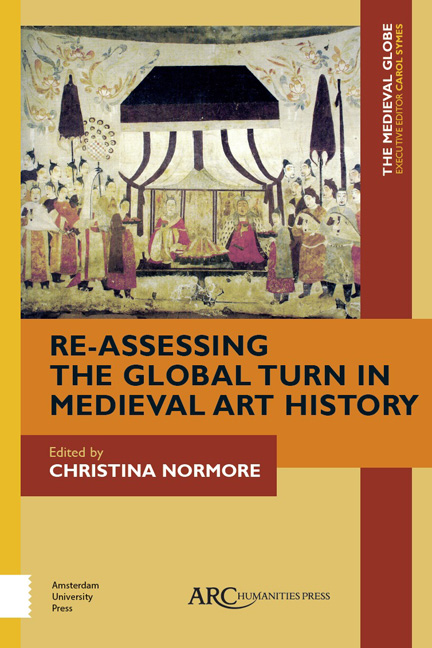Book contents
- Frontmatter
- Contents
- List of Illustrations
- Editor’s Introduction: A World within Worlds? Reassessing the Global Turn in Medieval Art History
- A Camel’s Pace: A Cautionary Global
- The Fatimid Holy City: Rebuilding Jerusalem in the Eleventh Century
- Worldliness in Byzantium and Beyond: Reassessing the Visual Networks of Barlaam and Ioasaph
- Exchange of Sacrifices: West Africa in the Medieval World of Goods
- The Beryozovo Cup: A Byzantine Object at the Crossroads of TwelfthCentury Eurasia
- Mobile Meanings: A Global Approach to a Dagger from Greater Syria
- Global Medieval at the “End of the Silk Road,” circa 756 CE: The Shōsō-in Collection in Japan
- Response: Medievalists and Early Modernists—A World Divided?
- Index
Global Medieval at the “End of the Silk Road,” circa 756 CE: The Shōsō-in Collection in Japan
Published online by Cambridge University Press: 23 January 2021
- Frontmatter
- Contents
- List of Illustrations
- Editor’s Introduction: A World within Worlds? Reassessing the Global Turn in Medieval Art History
- A Camel’s Pace: A Cautionary Global
- The Fatimid Holy City: Rebuilding Jerusalem in the Eleventh Century
- Worldliness in Byzantium and Beyond: Reassessing the Visual Networks of Barlaam and Ioasaph
- Exchange of Sacrifices: West Africa in the Medieval World of Goods
- The Beryozovo Cup: A Byzantine Object at the Crossroads of TwelfthCentury Eurasia
- Mobile Meanings: A Global Approach to a Dagger from Greater Syria
- Global Medieval at the “End of the Silk Road,” circa 756 CE: The Shōsō-in Collection in Japan
- Response: Medievalists and Early Modernists—A World Divided?
- Index
Summary
There is no museum of antiquities in the world, so far as I know, half so instructive to the European as this rare collection at Nara. … Where else could we see these strange connecting links between the arts of Egypt, India, China, and Japan, that we Find here?
WHEN CHRISTOPHER DRESSER (1834– 1904), Scottish designer and theorist, travelled to Japan in 1876 as a representative of the South Kensington Museum in London (later to become the Victoria & Albert Museum), little prepared him for what the ancient Japanese capital of Nara held in store. His tour of “the Mikado's treasures” preserved at the repository at the Shōsō-in 正倉院 filled him with awe and disbelief ( Figure 8.1 ). This repository, first assembled in the mideighth century, encompasses artifacts that were created, traded, and (in some cases) made to order along the Silk Road. It was hardly known outside Japan at the time of Dresser's writing. It would take the work of Ernest Fenollosa (1853– 1908), the first curator of Oriental Art at the Museum of Fine Arts in Boston, for the Shōsō in to be properly introduced to readers and museumgoers in the West. 2 By his reckoning, the repository proves that “the seeds of civilization in Japan were sowed during Alexander's conquest of Asia, and were in turn imparted to Japan via China and Korea.” This language of “globalism” continues to inform both public and scholarly discourses on the Shōsō in to the present day. Within Japan, the collection has been customarily labelled as the “final destination of the Silk Road.” The Lithuaniaborn Fluxus artist George Maciunas (1931– 1978), who took classes on Asian art at the Institute of Fine Arts in New York, recuperated the Sh ōsō in as a token of artistic catholicism and exquisite craftsmanship when he named the group's first mailorder set the “Shosoin warehouse of today” in 1965.
Less acknowledged is the fact that this prodigious collection of global art first came into existence owing to concerns that were ultimately local, religious, and maritorious. As the various routes these objects travelled converged in Japan, their collective identity as an ensemble also became significant.
- Type
- Chapter
- Information
- Re-Assessing the Global Turn in Medieval Art History , pp. 177 - 202Publisher: Amsterdam University PressPrint publication year: 2018



